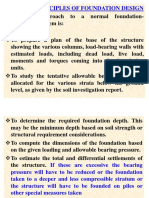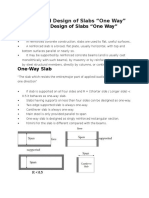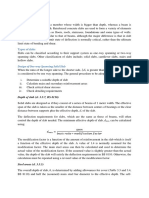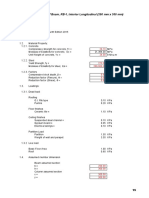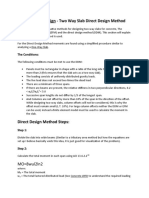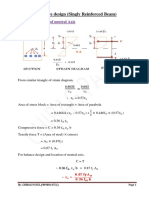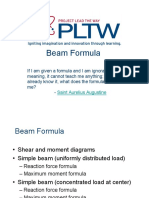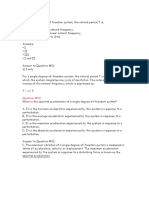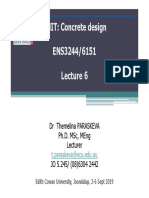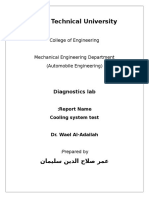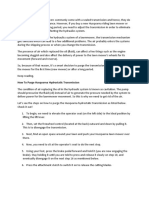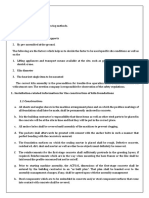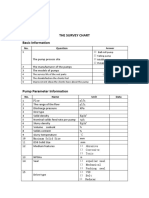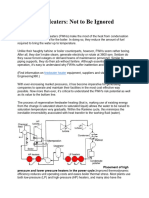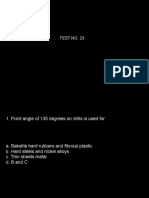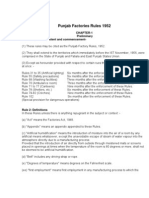Computer Aided Design Lab (CEL6302)
Computer Aided Design Lab (CEL6302)
Week 5
3. Design of one-way slab using MS- EXCEL
One-way slab: - One way slab is defined as the slab which carry the load along one direction. The
slab is supported from two sides or the ratio of longer span to shorter span is greater than or equal
to two. The deflection or bending in such slab occurred in the direction along its shorter span.
𝑙𝑥
𝑙𝑦
One-Way slab
𝑙𝑥
𝒍𝒚 𝑙𝑥
≥𝟐
𝒍𝒙
𝑙𝑦 𝑙𝑦
One-Way slab One-Way slab
𝑙𝑥 𝒍𝒚 𝑙𝑥
<𝟐
𝒍𝒙
𝑙𝑦 𝑙𝑦
Two-Way slab Two-Way slab
Due to the huge difference in lengths, the load is not transferred to the shorter beams. Main
reinforcement is provided in shorter span and distribution reinforcement in a longer span.
1
NIT Patna Dr. Arya Anuj Jee
�Computer Aided Design Lab (CEL6302)
Example: Generally all the Cantilever slabs are one Way slab. Chajjas and verandahs are a practical
example of one way slab.
Two-way slab: - Two-way slabs are supported on all sides which carry the load in all four
direction. The ratio of longer span to shorter span is less than two.
Difference between one-wat and two way slab
S.No One-way Slab Two-way Slab
If ly/lx the ratio is greater than or equal 2 or If ly/lx the ratio is less than 2 then it is
1
then it is considered a one-way slab. considered a two-way slab.
In one-way slab, the main reinforcement is
In two-way slab, the main reinforcement is
2 provided in a short span and distribution
provided in both directions.
reinforcement is provided in a long span.
In one-way slab, the crank is provided in two In two-way slab, the crank is provided in
3
directions. four directions.
The one-way slab is supported by a beam on The two-way slab is supported by the beam
4
two opposite side only. on all four sides.
In one-way slab, the load is carried in one
In two-way slab, the load is carried in both
5 direction perpendicular to the supporting
directions.
beam.
The deflected shape of the one-way slab is Whereas the deflected shape of the two-
6
cylindrical. way slab is a dish or saucer-like shape.
Whereas two-way slabs are used in
Chajja and Varandha are practical examples
7 constructive floors of the Multistorey
of one-way slab
building.
While designing one-way slab we provide While designing two-way slab we provide
less steel hence the depth of the slab more steel hence the depth of slab
8 increases, as a result, the thickness of the decreases, as a result, the thickness of two-
one-way slab is more as compared to the way slab is less as compared to the one-
two-way slab. way slab.
The one-way slab is economical up to a span Whereas the two-way slab is economical
9
of 3.6 meters. for the panel sizes up to 6m × 6m.
In two-way slab quantity of steel is more as
10 In one-way slab quantity of steel is less.
compared to the one-way slab.
In one-way slab, bending is only in one In a two-way slab, bending is in both
11
direction i.e. in a shorter span. directions.
2
NIT Patna Dr. Arya Anuj Jee
�Computer Aided Design Lab (CEL6302)
Reinforcement in slab
Distribution
Reinforcement
Shorter
Span Main
Reinforcement
The main reinforcement if provided along the shorter span to resist the bending moment or
governing moment.
The distribution reinforcement if provided along the longer span to resist the temperature and
shrinkage stresses and for reducing the deflection.
Analysis and design of one-way slab
𝒍𝒚
𝟏m
𝒍𝒙
leff
L0
W W
The analysis and design of slab will be done for one meter along the longer span. And same
design was used for remaining slab.
3
NIT Patna Dr. Arya Anuj Jee
�Computer Aided Design Lab (CEL6302)
3. Design steps for one way slab
Materials properties
They have prescribed the material properties or we can select according to given conditions based
on IS 456: 2000
𝑓𝑐𝑘 = characteristic strength of concrete
𝑓𝑦 = yield strength of steel
For𝑓𝑐𝑘 , or to determine the grade of concrete, if not given
4
NIT Patna Dr. Arya Anuj Jee
�Computer Aided Design Lab (CEL6302)
Step 1: Determination of type of slab
𝐿𝑦
If the slab is supported from two sides or the ratio of longer span to shorter span = 𝐿 > 2 the
𝑥
slab is one-way slab
𝐿𝑦
If the ratio of longer span to shorter span = 𝐿 ≤ 2 the slab is two-way slab
𝑥
Step 2: Calculation of effective depth
Initialy we will assume the effective depth
from Page 37, Section 23.2.1, IS 456 2000
5
NIT Patna Dr. Arya Anuj Jee
�Computer Aided Design Lab (CEL6302)
Step 3: Calculation of effective span
From page 34, Section 22.2, IS 456 2000
(a) Simply supported slab
leff
L0
W W
(𝑑𝑖𝑠𝑡𝑎𝑛𝑐𝑒 𝑏𝑒𝑡𝑤𝑒𝑒𝑛 𝑠𝑢𝑝𝑝𝑜𝑟𝑡)
𝑙𝑒𝑓𝑓 = { } 𝑤ℎ𝑖𝑐ℎ 𝑜𝑛𝑒 𝑖𝑠 𝑚𝑖𝑛𝑖𝑚𝑢𝑚
(𝑐𝑙𝑒𝑎𝑟 𝑠𝑝𝑎𝑛 + 𝑑𝑒𝑓𝑓 )
6
NIT Patna Dr. Arya Anuj Jee
�Computer Aided Design Lab (CEL6302)
(b) Continuous slab
𝒍𝟎 𝟏 𝒍𝟎 𝟐 𝒍𝟎 𝟑
𝑙𝑒𝑓𝑓 = 𝑙0 1 𝑙𝑒𝑓𝑓 = 𝑙0 2 𝑾 𝑊
𝑙𝑒𝑓𝑓 = 𝑙0 3 +
2
Whichever
Or
is less?
𝑑
𝑙𝑒𝑓𝑓 = 𝑙0 3 +
2
(c) Cantilever slab
𝒍𝟎
𝑑
𝑙𝑒𝑓𝑓 = 𝑙0 3 +
2
(d) Frames
𝑙𝑒𝑓𝑓
7
NIT Patna Dr. Arya Anuj Jee
�Computer Aided Design Lab (CEL6302)
Step 4: Load calculation
Use IS: 875 (Part 1) – 1987 for dead loads—unit weights of building materials and stored
materials and IS: 875 (Part 2) – 1987 for design loads (other than earthquake) for buildings
and structures
Three types of loads are to be considered for the design of slabs:
o Dead load of the slab
𝐷𝑒𝑎𝑑 𝑙𝑜𝑎𝑑 = 𝑣𝑜𝑙𝑢𝑚𝑒 𝑜𝑓 𝑜𝑛𝑒 𝑚𝑒𝑡𝑒𝑟 𝑚𝑒𝑚𝑏𝑒𝑟 ×
𝑢𝑛𝑖𝑡 𝑤𝑒𝑖𝑔ℎ𝑡 𝑜𝑓 𝑚𝑎𝑡𝑒𝑟𝑖𝑎𝑙𝑠
o Live load of the slab
Live loads are different for different buildings and structures. It keeps
changing from time to time even on same structure. This is the temporary
load on its intensity depends on type and occupancy of building.
o Floor finish load
Load acting due to plaster, painting, tiles etc.
Calculate the ultimate load applied on the beam then find the design bending moment
according to IS 456: 2000, Table 18
o For example: Design bending moment or factored moment for simply supported
𝑤𝑢 𝑙2
slab will be = 8
Now check effective depth is sufficient to carry the design moment, for the required
depth (𝑑) ultimate moment will be:
o 𝑀𝑢 = 0.1498 𝑓𝑐𝑘 𝑏𝑑2 [for Fe 250]
o 𝑀𝑢 = 0.1389 𝑓𝑐𝑘 𝑏𝑑2 [for Fe 415]
o 𝑀𝑢 = 0.1338 𝑓𝑐𝑘 𝑏𝑑2 [for Fe 500]
There should be 𝑑𝑝𝑟𝑜𝑣 > 𝑑𝑟𝑒𝑞 then fix the dimension of rectangular section
8
NIT Patna Dr. Arya Anuj Jee
�Computer Aided Design Lab (CEL6302)
Step 5: Reinforcement calculations
𝐴𝑠𝑡 𝑓𝑐𝑘 𝑀𝑢
= [1 − √1 − 4.598 ]
𝑏𝑑 2𝑓𝑦 𝑓𝑐𝑘 𝑏𝑑 2
Check for minimum steel 𝐴𝑠𝑡 , 𝑚𝑖𝑛, from Section 26.5.2.1, IS 456 2000
0.15 % 𝑓𝑜𝑟 𝑚𝑖𝑙𝑑 𝑠𝑡𝑒𝑒𝑙
0.12 % 𝑓𝑜𝑟 𝐻𝑌𝑆𝐷 𝑠𝑡𝑒𝑒𝑙
If 𝐴𝑠𝑡 obtained from the formula is less than the 𝐴𝑠𝑡 , 𝑚𝑖𝑛, then use 𝐴𝑠𝑡 , 𝑚𝑖𝑛 as a main
reinforcement,
If 𝐴𝑠𝑡 obtained from the formula is greater than the 𝐴𝑠𝑡 , 𝑚𝑖𝑛, then use 𝐴𝑠𝑡 as a main
reinforcement,
𝐴𝑠𝑡 , 𝑚𝑖𝑛 will be used for distribution reinforcement.
Now assume the diameter of bar according to obtained 𝑨𝒔𝒕 and find the spacing between
reinforcement
𝑎𝑠𝑡
Spacing between main reinforcement= 𝐴 × 1000, take lower round off value (Reduce
𝑠𝑡 𝑜𝑟 𝐴𝑠𝑡 𝑚𝑖𝑛
the spacing for serviceability)
𝑎𝑠𝑡
Spacing between distribution reinforcement= 𝐴 × 1000, take lower round off value
𝑠𝑡 𝑚𝑖𝑛
(Reduce the spacing for serviceability)
From Section 26.3.3, IS 456 2000,
9
NIT Patna Dr. Arya Anuj Jee
�Computer Aided Design Lab (CEL6302)
The maximum spacing between two parallel main reinforcing bars in case of Slab shall be
3𝑑 𝑜𝑟 300 𝑚𝑚 or whichever is less. The maximum spacing between two distribution steel bars in
case of Slab shall be 5𝑑 𝑜𝑟 450 𝑚𝑚 or whichever is less.
Step 6: Check for shear
𝑤𝑢 𝑙
𝐹𝑎𝑐𝑡𝑜𝑟𝑒𝑑 𝑠ℎ𝑒𝑎𝑟 𝑓𝑜𝑟𝑐𝑒 (𝑣𝑢 ) = [For simply supported slab]
2
Now find the nominal shear stress according to IS 456: 2000, Section: 40.1
𝑣𝑢
𝜏𝑣 =
𝑏𝑑
Now find the percentage of tension reinforcement
𝐴𝑠𝑡
𝑝𝑡 = × 100
𝑏𝑑
Now design shear strength of concrete (𝜏𝑐 ) according to IS 456: 2000, Table 19
o Find 𝜏𝑐 for given percentage of tension reinforcement
10
NIT Patna Dr. Arya Anuj Jee
�Computer Aided Design Lab (CEL6302)
o Compared with shear stress of slab 𝜏𝑣 with design shear strength of concrete (𝜏𝑐 )
if 𝜏𝑣 < 𝜏𝑐 then no need of shear reinforcement
if 𝜏𝑣 > 𝜏𝑐 followed the Section 40.3, IS 456: 2000 for design of shear
reinforcement
Step 7: Check for deflection
(Follow the steps given in IS 456: 2000, page 38, Fig 4)
𝐴𝑟𝑒𝑎 𝑜𝑓 𝑐𝑟𝑜𝑠𝑠 𝑠𝑒𝑐𝑡𝑖𝑜𝑛 𝑜𝑓 𝑠𝑡𝑒𝑒𝑙 𝑟𝑒𝑞𝑢𝑖𝑟𝑒𝑑 𝐴𝑠𝑡 𝑟𝑒𝑞
𝑓𝑠 = 0.58 𝑓𝑦 =
𝐴𝑟𝑒𝑎 𝑜𝑓 𝑐𝑟𝑜𝑠𝑠 𝑠𝑒𝑐𝑡𝑖𝑜𝑛 𝑜𝑓 𝑠𝑡𝑒𝑒𝑙 𝑝𝑟𝑜𝑣𝑖𝑑𝑒𝑑 𝐴𝑠𝑡 𝑝𝑟𝑜𝑣
11
NIT Patna Dr. Arya Anuj Jee
�Computer Aided Design Lab (CEL6302)
𝑎𝑠𝑡
𝐴𝑠𝑡 𝑝𝑟𝑜𝑣 = × 1000
𝑆
𝐴𝑠𝑡 𝑝𝑟𝑜𝑣
Percentage of tension reinforcement = × 100
𝑏𝑑
From Fig 4, find modification factor and find the value of effective depth required
𝑙
= 𝐵𝑎𝑠𝑖𝑐 𝑣𝑎𝑙𝑢𝑒 × 𝑀𝑜𝑑𝑖𝑓𝑖𝑐𝑎𝑡𝑖𝑜𝑛 𝑓𝑎𝑐𝑡𝑜𝑟
𝑑
If 𝑑𝑝𝑟𝑜𝑣 > 𝑑𝑟𝑒𝑞 So, slab is safe for deflection
Step 8: Development length
Development length is the minimum length of the bar which must be embedded in concrete beyond
any section to develop its full strength and in case of axial tension or axial compression,
development length is also known as an anchorage length.
If the development length is not provided at the time of construction the beam will come out of the
concrete column. So, to provide support to the beam and to reduce the chances of the beam coming
out of the concrete column this length is needed.
To design the development of length follow the Section 26.2.1, IS 456 2000
12
NIT Patna Dr. Arya Anuj Jee
�Computer Aided Design Lab (CEL6302)
𝜎𝑠 ∅ 0.87 𝑓𝑦 ∅
𝐿𝑑 = =
4𝜏𝑏𝑑 4𝜏𝑏𝑑
According to code from Page 44, Section 26.2.3.3, IS 456 2000
13
NIT Patna Dr. Arya Anuj Jee
�Computer Aided Design Lab (CEL6302)
𝑀1
𝐿𝑑 ≤ 1.3 + 𝐿𝑜
𝑉
𝑀1 = 0.87 𝑓𝑦 𝐴𝑠𝑡1 (𝑑 − 0.42 𝑥𝑢 )
𝐴𝑠𝑡 1 = 𝐴𝑠𝑡 𝑛𝑒𝑎𝑟 𝑠𝑢𝑝𝑝𝑜𝑟𝑡 𝑡𝑜 𝑟𝑒𝑠𝑖𝑠𝑡 𝑡𝑒𝑛𝑠𝑖𝑜𝑛
From page 96, IS 456 2000
0.87𝑓𝑦 𝐴𝑠𝑡1
𝑥𝑢 =
0.36 𝑓𝑐𝑘 𝑏
𝐿0 = 𝑑 𝑜𝑟 12 ∅ 𝑤ℎ𝑖𝑐ℎ𝑒𝑣𝑒𝑟 𝑖𝑠 𝑔𝑟𝑒𝑎𝑡𝑒𝑟, Page 44, IS 456 2000
Example
Design a RC slab for a room having inside dimensions 3 m × 7 m. The thickness of supporting
wall is 300 mm. The live load on the slab may be taken as 2 kN/m2. Assume slab is simply
supported at the ends. Use M 20 and Fe 415 Materials.
Solution
Given dimensions = 3 𝑚 (𝑙𝑥 ) × 7 𝑚(𝑙𝑦 ) (inside dimension)
Wall thickness or bearing = 𝑊 = 300 𝑚𝑚
LL = 2 𝑘𝑁/𝑚2
Slab is simply supported
𝐹𝑐𝑘 = 20 𝑁/𝑚𝑚2 , 𝑓𝑦 = 415 𝑁/𝑚𝑚2
Step 1: Determination of type of slab
𝐿𝑦 = 7𝑚, 𝐿𝑥 = 3𝑚
14
NIT Patna Dr. Arya Anuj Jee
�Computer Aided Design Lab (CEL6302)
𝐿𝑦 7
Ratio of longer span to shorter span = 𝐿 = 3 = 2.33 > 2
𝑥
As the ratio is greater than 2, therefore, the given slab is one-way slab
𝒍𝒚
𝟏m
𝒍𝒙
leff
L0
W W
Step 2: Calculation of effective depth
From Page 37, IS 456 2000
𝑙 3000
For simply supported case 𝑑 𝑥 = 20, = 20
𝑒𝑓𝑓 𝑑𝑒𝑓𝑓
𝑑𝑒𝑓𝑓 = 150 𝑚𝑚
Assume effective cover 𝑑 ′ = 25 𝑚𝑚
Overall depth, 𝐷 = 𝑑𝑒𝑓𝑓 + 𝑑 ′ = 150 + 25 = 175 𝑚𝑚
Step 3: Calculation of effective span
From page 34, Section 22.2, IS 456 2000
(For simply supported beam or slab, the effective span of a member that is not built integrally
with its supports shall be taken as clear span plus the effective depth of slab or beam, or center
to center of supports. whichever is less, as per IS 456: 2000, Section: 22.2)
15
NIT Patna Dr. Arya Anuj Jee
�Computer Aided Design Lab (CEL6302)
3 + 0.15 + 0.15 𝑚 = 3.3 𝑚 (𝑐𝑒𝑛𝑡𝑒𝑟 𝑡𝑜 𝑐𝑒𝑛𝑡𝑒𝑟 𝑑𝑖𝑠𝑡𝑎𝑛𝑐𝑒 𝑏𝑒𝑡𝑤𝑒𝑒𝑛 𝑠𝑢𝑝𝑝𝑜𝑟𝑡)
𝑙={
3 + 0.15 = 3.15 𝑚 (𝑐𝑙𝑒𝑎𝑟 𝑠𝑝𝑎𝑛 + 𝑑)
Take lesser value = 𝑙 = 3.15 𝑚
Step 4: Load calculation
𝑘𝑁
∆𝑤𝐷𝐿 𝑜𝑟 𝑠𝑒𝑙𝑓 𝑤𝑒𝑖𝑔ℎ𝑡 𝑜𝑓 𝑠𝑙𝑎𝑏 = 25 𝑚3 × 0.175 𝑚 × 1 𝑚 = 4.375 𝑘𝑁/𝑚2,
𝑘𝑁
[25 𝑚3 𝑖𝑠 𝑡ℎ𝑒 𝑑𝑒𝑛𝑠𝑖𝑡𝑦 𝑜𝑓 𝑐𝑜𝑛𝑐𝑟𝑒𝑡𝑒]
Note: Slab will be design for 1 meter width
𝐿𝑖𝑣𝑒 𝑙𝑜𝑎𝑑 = ∆𝑤𝐿𝐿 = 2 𝑘𝑁/𝑚2
𝐹𝑙𝑜𝑜𝑟 𝑓𝑖𝑛𝑖𝑠ℎ = ∆𝑤𝐹𝐹 = 1.75 𝑘𝑁/𝑚2 [Assumed]
Therefore, 𝑇𝑜𝑡𝑎𝑙 𝐿𝑜𝑎𝑑, 𝑤 = 4.375 + 2 + 1.75 = 8.125 𝑘𝑁/𝑚2
𝑈𝑙𝑡𝑖𝑚𝑎𝑡𝑒 𝑙𝑜𝑎𝑑, 𝑤𝑢 = 1.5 × 𝑤 = 8.125 × 1.5 = 12.1875 𝑘𝑁/𝑚2
𝑤𝑢 𝑙2
The ultimate moment 𝑀𝑢 = = 15.116 𝑘𝑁𝑚
8
𝑚 15.116 ×106
Effective depth required 𝑑𝑟𝑒𝑞 = √0.138 𝑢𝑓 = √0.138 ×20×1000 = 74 𝑚𝑚
𝑐𝑘 𝑏
Now, 𝑑𝑝𝑟𝑜𝑣 > 𝑑𝑟𝑒𝑞 so safe
Step 5: Reinforcement calculations
𝐴𝑠𝑡 𝑓𝑐𝑘 𝑀𝑢
= [1 − √1 − 4.598 ]
𝑏𝑑 2𝑓𝑦 𝑓𝑐𝑘 𝑏𝑑 2
20 15.116 × 106
𝐴𝑠𝑡 = [1 − √1 − 4.598 ] 1000 × 150 = 291 𝑚𝑚2
2(415) 20 × 100 × 1502
Check for minimum steel 𝐴𝑠𝑡 , 𝑚𝑖𝑛
From Section 26.5.2.1, IS 456 2000
0.15 % 𝑓𝑜𝑟 𝑚𝑖𝑙𝑑 𝑠𝑡𝑒𝑒𝑙
0.12 % 𝑓𝑜𝑟 𝐻𝑌𝑆𝐷 𝑠𝑡𝑒𝑒𝑙
𝐴𝑠𝑡 , min = 0.12 % 𝑏𝐷 = 0.12 × 1000 × 175 = 210𝑚𝑚, also known as distribution steel
16
NIT Patna Dr. Arya Anuj Jee
�Computer Aided Design Lab (CEL6302)
𝐴𝑠𝑡 > 𝐴𝑠𝑡 , 𝑚𝑖𝑛, Ok
From Section 26.5.2.2, IS 456 2000
The diameter of reinforcing bar shall not exceed one eight of the total thickness of the slab
175𝑚𝑚
Maximum diameter of steel bar = = 21.87 𝑚𝑚
8
Provide 8 𝑚𝑚 ∅ 𝑏𝑎𝑟𝑠, 𝑎𝑠𝑡 = 50.26 𝑚𝑚2
𝑎 50.26
Spacing = 𝐴𝑠𝑡 1000 = × 1000 = 172.7 𝑚𝑚 𝑐/𝑐 < 3d or 300 mm as per Section 26.3.3, IS
𝑠𝑡 291
456 2000
Provide 8 𝑚𝑚 ∅ 𝑏𝑎𝑟𝑠 @ 150 mm c/c as main reinforcements
Reduce the spacing for serviceability
Spacing for distribution steel
𝑎
𝑠𝑡 50.26
Spacing = 210 1000 = × 1000 = 239 𝑚𝑚 𝑐/𝑐 < 5d or 450 mm as per Section 26.3.3, IS
210
456 2000
Provide 8 𝑚𝑚 ∅ 𝑏𝑎𝑟𝑠 @ 200 mm c/c as distribution reinforcement
Step 6: Check for shear
Critical shear will occurred at support
𝑤𝑢 𝑙 3.15
𝑣𝑢 = = 12.1875 × = 19.19 𝑘𝑁
2 2
Now find the Nominal shear stress according to IS 456: 2000, Section: 40.1
𝑣𝑢 19.19 × 103
𝜏𝑣 = = = 0.128 𝑁/𝑚𝑚2
𝑏𝑑 1000 × 150
Now find the percentage of tension reinforcement
For Min Ast 0.12%, 𝜏𝑐 = 0.28 𝑁/𝑚𝑚2
Therefor, 𝜏𝑣 < 𝜏𝑐 , the slab is safe in shear.
Step 7: Check for deflection
(Follow the steps given in IS 456: 2000, page 38, Fig 4)
𝑎𝑠𝑡 50.26
𝐴𝑠𝑡 𝑝𝑟𝑜𝑣 = × 1000 = × 1000 = 335 𝑚𝑚2
𝑆 150
𝐴𝑟𝑒𝑎 𝑜𝑓 𝑐𝑟𝑜𝑠𝑠 𝑠𝑒𝑐𝑡𝑖𝑜𝑛 𝑜𝑓 𝑠𝑡𝑒𝑒𝑙 𝑟𝑒𝑞𝑢𝑖𝑟𝑒𝑑 291 𝑁
𝑓𝑠 = 0.58 𝑓𝑦 = 0.58 × 415 × = 209
𝐴𝑟𝑒𝑎 𝑜𝑓 𝑐𝑟𝑜𝑠𝑠 𝑠𝑒𝑐𝑡𝑖𝑜𝑛 𝑜𝑓 𝑠𝑡𝑒𝑒𝑙 𝑝𝑟𝑜𝑣𝑖𝑑𝑒𝑑 335 𝑚𝑚2
𝐴𝑠𝑡 𝑝𝑟𝑜𝑣 335
Percentage of tension reinforcement = × 100 = 1000×150 × 100
𝑏𝑑
17
NIT Patna Dr. Arya Anuj Jee
�Computer Aided Design Lab (CEL6302)
From fig 4, modification factor = 2
𝑙
= 20 × 2 = 40
𝑑
3150
𝑑= = 78.75 𝑚𝑚
20 × 2
𝑑𝑝𝑟𝑜𝑣 (150 𝑚𝑚) > 𝑑𝑟𝑒𝑞 (78.75 𝑚𝑚)
So, safe for deflection
Step 7: Check for development length
From Page 42, Section 26.2.1, IS 456 2000
𝜎𝑠 ∅ 0.87 𝑓𝑦 ∅
𝐿𝑑 = =
4𝜏𝑏𝑑 4𝜏𝑏𝑑
From Page 43, Section 26.2.1.1, IS 456 2000
For M 20 𝜏𝑏𝑑 = 1.2
0.87 × 415 × 8
𝐿𝑑 = = 601.75 𝑚𝑚
4 × 1.2
According to code for simply supported beam/slab,
From Page 44, Section 26.2.3.3, IS 456 2000
𝑀1
𝐿𝑑 ≤ 1.3 + 𝐿𝑜
𝑉
𝑀1 = 0.87 𝑓𝑦 𝐴𝑠𝑡1 (𝑑 − 0.42 𝑥𝑢 )
335
𝐴𝑠𝑡 1 = 𝐴𝑠𝑡 𝑛𝑒𝑎𝑟 𝑠𝑢𝑝𝑝𝑜𝑟𝑡 𝑡𝑜 𝑟𝑒𝑠𝑖𝑠𝑡 𝑡𝑒𝑛𝑠𝑖𝑜𝑛 = = 167.5 𝑚𝑚2
2
From page 96, IS 456 2000
0.87𝑓𝑦 𝐴𝑠𝑡1 0.87 × 415 × 167.5
𝑥𝑢 = = = 8.39 𝑚𝑚
0.36 𝑓𝑐𝑘 𝑏 0.36 × 20 × 1000
𝑀1 = 0.87 × 415 × 167.5 × (150 − 0.42 × 8.39) = 8858276.36 𝑁 𝑚𝑚
𝑉 = 19.19 × 103 𝑁
Page 44, IS 456 2000
𝐿0 = 𝑑 𝑜𝑟 12 ∅ 𝑤ℎ𝑖𝑐ℎ𝑒𝑣𝑒𝑟 𝑖𝑠 𝑔𝑟𝑒𝑎𝑡𝑒𝑟
𝑑 = 150 𝑚𝑚
12 ∅ = 12 × 8 = 72 𝑚𝑚
18
NIT Patna Dr. Arya Anuj Jee
�Computer Aided Design Lab (CEL6302)
𝐿0 = 150 𝑚𝑚
8858276.36
1.3 + 150 = 750 𝑚𝑚
19.19 × 103
𝑀1
Here, 𝐿𝑑 < 1.3 + 𝐿𝑜
𝑉
Ok in length development
19
NIT Patna Dr. Arya Anuj Jee




